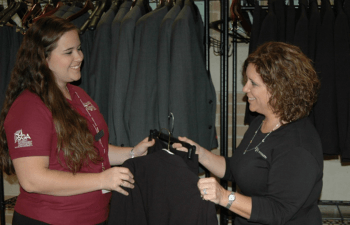Aggies Satisfied With Education, Bucking National Trend
Although a national poll of recent college graduates shows only half “strongly agree” their college education was worth the cost, the story is decidedly different at Texas A&M University. Nearly 90 percent of recent Texas A&M grads surveyed said they were “very” or “extremely satisfied” with their undergraduate education.
This level of satisfaction is no easy feat considering that at more than 64,000, Texas A&M has the largest college student population in Texas and one of the top five in the nation.
Earlier this year the university surveyed 1,800 of its former students who graduated one, four and seven years ago. In addition to the nearly 90 percent approval of undergraduate programs, 90.3 percent of respondents rated faculty in their major department as “good” or “excellent.” Additionally, 86.1 percent reported that Texas A&M prepared them for their chosen career “generally” or “very well.” And 90.3 percent stated that based on experiences working with graduates from other institutions or in studying at another university, a degree from Texas A&M is “above” or “well above average” compared to other institutions.

“At a time when many question the value of a college education relative to the cost of attaining a degree, we are proud to consistently rank at or near the top in surveys that recognize our remarkably affordable costs as well as exceptional career opportunities,” said Texas A&M President Michael K. Young.
Another survey, the Student Experience in the Research University (SERU), has been administered each of the last four years to a total of nearly 35,000 current Texas A&M students. In 2012, of the six large research institutions that participated — all, like Texas A&M, members of the Association of American Universities (AAU) — students at Texas A&M reported the highest level of satisfaction with the “value of education for the price you are paying.” In 2013, of the 14 large research institutions (all AAU) that participated, students at Texas A&M ranked second only to the University of North Carolina (UNC) in their level of satisfaction with the value of education for the price. Also that year, Texas A&M tied for first with UNC on “this institution has a strong commitment to undergraduate education” and scored the highest on the importance of the university’s prestige when applying for a job. And in 2014, more than 10,000 undergrad Texas A&M students participated in SERU, rating the university highest on the level of satisfaction for “value of education for the price you are paying.”
As a tier-one research university, Texas A&M draws world-class faculty, including Nobel Laureates and winners of the prestigious Wolf Prize. The Texas A&M Institute for Advanced Study draws eminent scholars from around the world to study and conduct research with Texas A&M students and faculty. Data shows Texas A&M students are highly satisfied with the university’s faculty: the website “Rate My Professors” just released its 2014-2015 list of the universities with the best faculty as rated by current students and Texas A&M faculty placed in the Top 7 nationally.
Many college graduates today have registered major concerns about student loan debt, but graduates of Texas A&M leave school with one of the least burdensome debt loads — certainly in Texas — even with the university’s emphasis on providing high-quality education. This year, the U.S. Department of Education recognized Texas A&M for graduate success and low debt. The College Scorecard shows Texas A&M graduates have 10-year median earnings of $52,900, which exceed that of all other public universities in the state. Texas A&M’s median college-cost debt for its graduates is $19,213, the lowest for any Texas public university. Writing about a related report on the Department of Education’s “Homeroom” blog, a reporter for Forbes posted a story titled “30 Four-Year Schools with High Graduation Rates and Low Cost,” with Texas A&M one of only four public institutions cited. And Texas A&M consistently ranks in U.S. News & World Report “Great Schools, Great Prices” category – 2nd in the nation among public universities in 2014.
Also last year, the university ranked among the Top 4 public universities nationally and in the Top 2 in Texas for affordability and high return on investment, according to the website Payscale. The projected net ROI by Payscale for Texas A&M graduates — the added value of a Texas A&M degree compared to what is typically expected of a graduate — is $566,700, and it attributes an overall cost-of-education figure of $91,040 to Texas A&M.
The ultimate goal of any university is to help its students find rewarding careers, and according to numerous media outlets, Texas A&M graduates stand out in the job market. For example, Newsweek cited Texas A&M nationally as one of the “The Top Ten Public Schools For Getting A Well Paid Job.” And U.S. News & World Report published an article showing that no other university in the country had more current Fortune 100 CEOs at the time that article was prepared than Texas A&M – with four other schools, all Ivy League, tied with Texas A&M.
One of those CEOs is David Cordani, Texas A&M Class of 1988, who leads the health care giant Cigna, with 37,000 employees and operations in 30 countries. Cordani visited campus last month and said he credits his education at Texas A&M for much of his career success. “I was fortunate in that I left here with a great foundation of skills and experiences and most importantly a lot of what I would call the ‘X Factor of Texas A&M’ – the values, the beliefs and what is the underpinning in terms of the loyalty, the sense of service, the sense of respect,” he said.
Another vital resource for Texas A&M students is the Career Center. The center is a comprehensive career planning and employment service for students of all majors and classifications, providing one point of contact to expedite the recruiting efforts of companies and organizations.
Recruiter activity through the Career Center is on the rise; in the last year, 5,000 recruiting employers posted nearly 16,000 jobs on HireAggies.com. According to Career Center Director Leigh Turner, recruiters actively seek out Texas A&M grads due to their academic preparation, skills, and qualities they acquire at the university. “They value our students’ practical knowledge and problem-solving skills, their integrity, and leadership,” Turner noted.
Even the Wall Street Journal took notice a few years ago in its “Top 25 Recruiter Picks” list, in which recruiters ranked Texas A&M No. 2 in the nation on the basis of whose graduates were best prepared and most able to succeed.
Developing leaders of character is one of the university’s missions and is evident in programs all across campus including the Corps of Cadets, student government, and the over 1,000 student organizations, many of which are focused on career-oriented activities. SCONA (the Student Conference on National Affairs) annually brings delegates to campus from all over the nation to discuss topics of national importance, giving Texas A&M students the opportunity to interact with the nation’s highest academic scholars, government officials and well-known public figures.
Such “hands-on” learning opportunities abound at Texas A&M, surely contributing to Texas A&M grads’ satisfaction with the university experience. Startup Aggieland, as another example, is a student-run business accelerator which gives students advice and resources to start their own business; the endeavor has already resulted in a number of successful operations. The Aggie 100 is a Mays Business School organization that identifies, recognizes and celebrates the 100 fastest growing Aggie-owned or Aggie-led businesses in the world.
Another factor that contributes to student satisfaction is campus culture. Texas A&M has been lauded by current and former students, and even visitors, for its friendly atmosphere. In 2014 the Daily Beast surveyed college students around the country to determine “The Happiest Colleges” and Texas A&M was No. 1 with a “Best Overall Student Experience” score of 10 out of 10, and a “Would Do It All Over Again” score of 9.8 out of 10.

Once they graduate, Texas A&M students become part of what’s known as the “Aggie Network,” a fellowship of more than 436,000 former students who, upon meeting, have an instant bond, often leading to job opportunities and other such perks.
Each year, the university recognizes its newest Distinguished Alumni with a formal gala. This year’s honorees included an award-winning architect, corporate giants, medical and legal professionals, war heroes and even a country music superstar. Invariably, these highly successful men and women credit much of their success to the education they received at Texas A&M and their related experiences at the university.
In a new twist to help future Aggie grads make an even better first impression during job interviews, just this week The Texas A&M University System announced that through the Chancellor’s Century Council members, Chancellor John Sharp has donated $70,000 to help create “suit banks” to lend clothes for student job applicants at the System’s 11 universities. The intent is to start the project in spring 2016 with 50 to 100 professional outfits for men and women, say System officials, who add they’ll be encouraging former students to donate suits. A similar “Career Closet” exists at Mays Business School.
Media contact: tamunews@tamu.edu.





